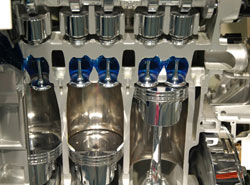Experimental data for diesel engine research
Numerical models are an important tool used by engineers in engine development. However, models are imperfect and must be continuously verified against experimental data. The MINNOX project funded by the Fifth Framework Programme aimed to reduce nitrogen oxide (NOx) emissions from Internal Combustion Engines (ICEs). The research relied heavily upon modelling techniques, thus it was imperative that actual engine data was available for comparison. The Chalmers University of Technology, a MINNOX partner from Sweden, performed a number of different experiments and assembled the results into a single database. A two-litre single cylinder Direct Injection (D.I.) diesel engine was used as a test bench. Two different thermo-pistons were employed to provide highly resolved temperature measurements on the surface of the piston and at the cylinder head. At the same time the concentration of NOx and other pollutants was analysed in the exhaust stream. Cylinder pressure and other parameters were also monitored in order to estimate total heat loss. In a second phase, an endoscope was added to perform flame imaging. It was necessary to allow the engine to warm up prior to recording so as to avoid interference from soot build-up. Pyrometry theory was subsequently used to calculate sooting flame temperature and the soot KL factor. For the final series of experiments, additional modifications were made to the engine to incorporate optical instrumentation. Specifically, information about the flow field within the combustion chamber was gathered with Laser Doppler Anemometry (LDA). Data from the three experimental phases was inserted into a central database that was made available to the other members of the MINNOX consortium for model verification purposes.







